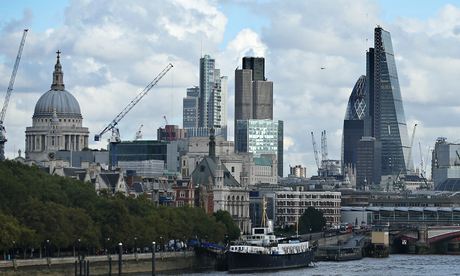

In the 17th century, poet James Wright wrote of St Paul's: 'Without, within, below, above, the eye is filled with unrestrained delight.' London's skyline is now dominated by the Gherkin and Cheesegrater. Photograph: Peter Macdiarmid/Getty Images
Some of Britain's most influential figures in the arts, politics and academia have launched a campaign to save London's skyline from being dominated by more than 200 additional skyscrapers.
In a statement in the Observer today, signatories from sculptor Sir Antony Gormley to philosopher Alain de Botton, author Alan Bennett, Stirling prize-winning architect Alison Brooks, and London mayoral hopefuls Dame Tessa Jowell and MP David Lammy warn: "The skyline of London is out of control."
More than 200 towers of at least 20 storeys are under construction or being planned, of which three-quarters will provide luxury residential flats, according to New London Architecture (NLA), a discussion and education forum.
The campaigners, who also include sculptor Sir Anish Kapoor,Restoration presenter Griff Rhys Jones, Charles Saumarez Smith, chief executive of the Royal Academy, and Lord Baker, the former Tory home secretary, pledge to fight what they describe as a fundamental and damaging transformation of London.
The campaign, which wants a skyline commission to examine London's future profile, has also obtained the support of the Observer's architecture critic, Rowan Moore. "It is shocking that such a profound change is being made to a great city with so little public awareness or debate," he said. "There is also a startling lack of oversight and vision from the city's leaders. These towers do not answer the city's housing needs, but respond to a bubble of international investment in London residential property. A short-term financial phenomenon will change the city's skyline forever."
A spokesman for the London mayor, Boris Johnson, said he would consider the idea of a commission and discuss it with interested parties this week, though he called for the campaigners to engage with the "distinguished names" on his own design advisory group.
The skyline campaign comes after the rejection by the high court two weeks ago of an appeal against a £600m development on the South Bank that Unesco says could threaten Westminster's world heritage status.
In their statement, more than 70 signatories, including societies and associations, write: "Over 200 tall buildings, from 20 storeys to much greater heights, are currently consented or proposed. Many of them are hugely prominent and grossly insensitive to their immediate context and appearance on the skyline.
"This fundamental transformation is taking place with a shocking lack of public awareness, consultation or debate.
"Planning and political systems are proving inadequate to protect the valued qualities of London, or provide a coherent and positive vision for the future skyline. The official policy is that tall buildings should be 'well designed and in the right place', yet implementation of policy is fragmented and weak.
"Too many of these towers are of mediocre architectural quality and badly sited. Many show little consideration for scale and setting, make minimal contribution to public realm or street-level experience and are designed without concern for their cumulative effect and impact. Their generic designs, typical of fast-growing cities around the world, threaten London's unique character and identity."
The majesty of St Paul's prompted the 17th-century poet James Wright to note: "Without, within, below, above, the eye is filled with unrestrained delight." Today, London's skyline is dominated by such sights as the Cheese-grater in Leadenhall, the Walkie-talkie in Fenchurch Street, the Gherkin in Aldgate and the Razor at Elephant and Castle. Towering above them all is the 1,000ft Shard next to London Bridge station.
Campaigners say they fear the consequences for London's appearance of a further 236 buildings of 20 storeys or more. According to the NLA, 77% of the skyscrapers will be in the centre or the east of London and result in the most radical reshaping of the skyline in more than 300 years. Tower Hamlets, Lambeth, Greenwich, Newham and Southwark between them will have 140 of the 236 towers. More than 30 will have between 40 and 49 floors and 22 with 50 or more.
On Thursday, Growing Up!, an exhibition at the NLA's offices, will highlight the extent of the skyscraper development about to hit the capital.
Many projects are funded by foreign investors seeking a safe berth – and healthy returns – for their money amid political instability in the Middle East, Russia and elsewhere. During the 12 months to January,London property values rose 13.2%.
The mayor's spokesman said that "virtually every one" of the towers had the support of local politicians and English Heritage, adding: "The mayor needs to balance an array of challenges and competing interests across a rapidly growing city. He recognises the concerns around the architecture of London's skyline, but tall buildings beautifully designed in the right location and in harmony with their surroundings help to meet the challenge of a rapidly growing city."
The NLA says that of the buildings being planned, 189 (80%) are intended to be residential, but do not meet London's housing needs because of their price and dimensions. A further 18 are planned as office developments, eight as hotels and 13 are due for mixed use, while one tower is to be an educational institute.
No comments:
Post a Comment
thank you for your precious time and feedback.